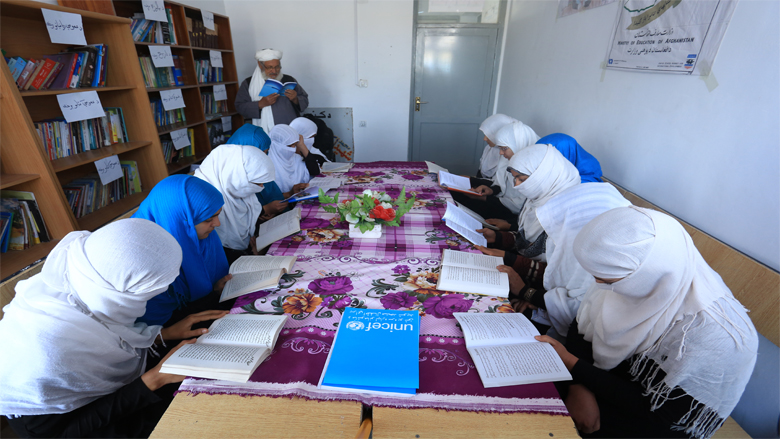KANDAHAR CITY – In an otherwise stark classroom, 51 bobbing heads covered in matching white scarves are focused intently on reciting their lessons, interrupted only by the sporadic rustle of a notebook on one of the many wooden desks. The 51 students, all in Grade 1, and all intent on mastering their Pashto lessons, repeat the alphabet after their teacher. The teacher alternates between chalking down instructions on the blackboard and stalling the recitation from time to time to correct their pronunciation.
It is just another school day at Shahid Khakrizwal Girls High School in district nine of Kandahar city. This was not always the case when the school had to battle many challenges because it did not have a permanent building. The hot spring and summer months made it difficult for students to attend classes regularly. Parents were not eager to send their girls to school and the girls who did enroll frequently fell ill from the extreme weather conditions that characterize the province. “Thank God, finally we have our own building with proper classrooms,” says Jamila, teacher at the school.
Fatima, 35, recalls the time when the school was housed in tents. “We had just four classes and in every class, there were only seven to eight girls,” she says. “We used to hold classes in tents. It was not possible to scale up to add additional grades.”
Enrollment has been on the increase since the school building was constructed. There are currently over 680 students from Grades 1 to 11 enrolled at the school. “Now, just in our first-grade class, we have more than 50 students and our enrollment has been increasing year by year,” says Fatima.
The students are also clearly happy with the improvements in their school. “When our school did not have a building, the noise from the road used to interrupt our lessons. It was also difficult to study under the sun’s heat in the summer and winters were too cold,” says Nasiba, a student. “Our lessons are much better and now I am confident that when I graduate from this school, I will be accepted at university.”
Established in 2004 as an elementary school, the school had few facilities up to 2008 when it came under the Educational Quality Improvement Program (EQUIP). In 2009, an Infrastructure Development Grant (IDG) from EQUIP enabled the school to build the two-storey school building that houses 20 classrooms. The benefits of having a permanent building however are not just limited to the number of grades or enrollment, but to the quality of education as well. From limited facilities and just five teachers, the school became a high school in 2014 and now has 20 teachers.
Shahid Khakrizwal Girls High School is one of 360 schools in Kandahar Province that have received both an IDG and Quality Enhancement Grant (QEG) under EQUIP.
EQUIP, now in its second phase, seeks to increase equitable access to quality basic education, especially for girls. It is implemented by the Ministry of Education and was first funded by the International Development Association (IDA), the World Bank Group’s fund for the poorest countries. The Afghanistan Reconstruction Trust Fund (ARTF) has taken over funding as co-financier of the project.

